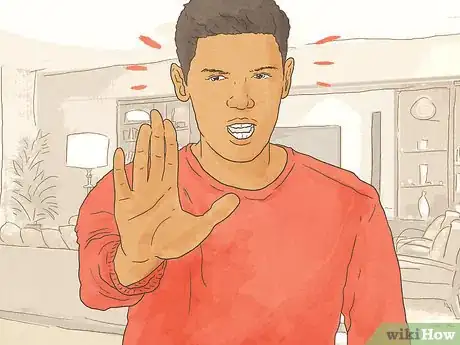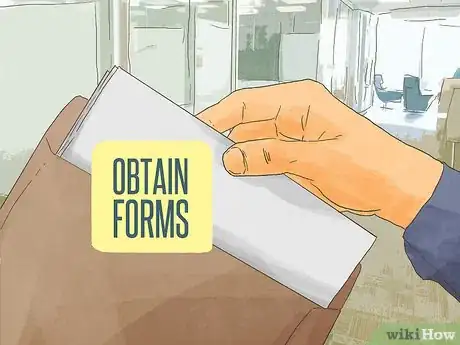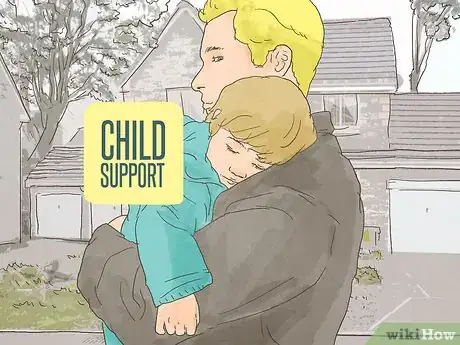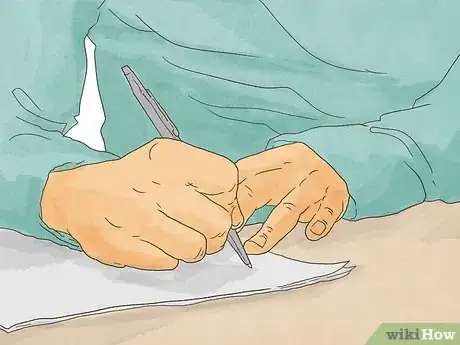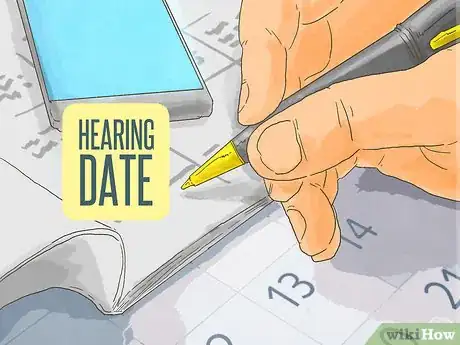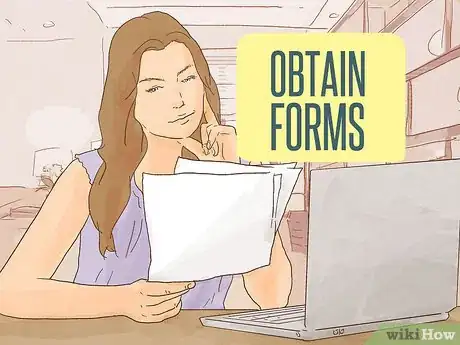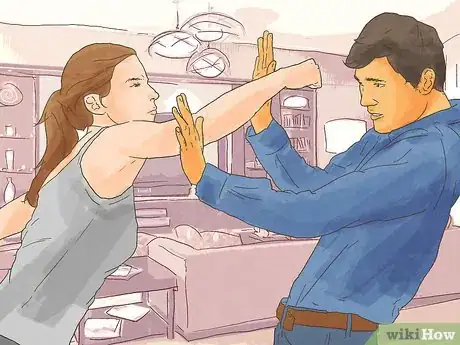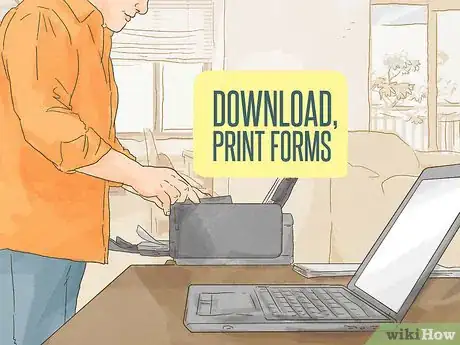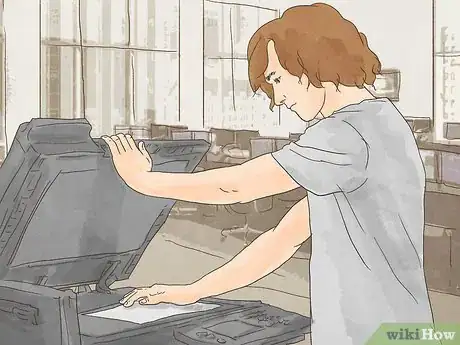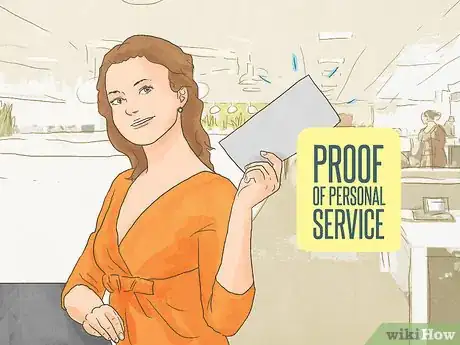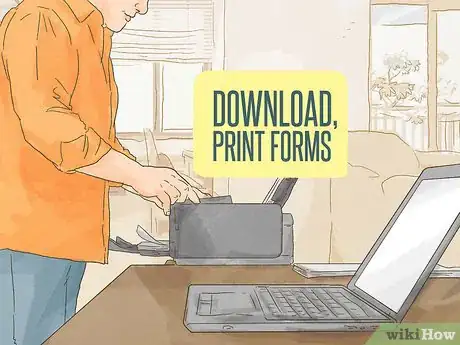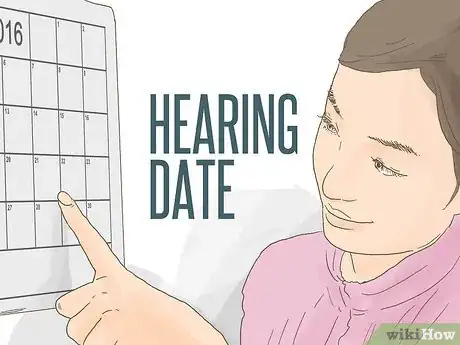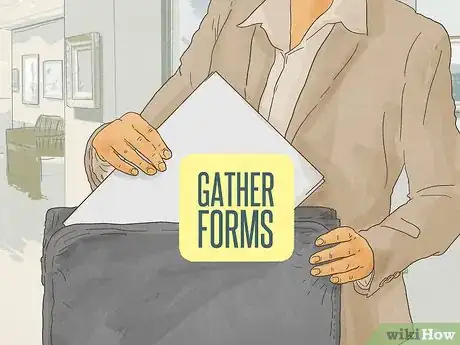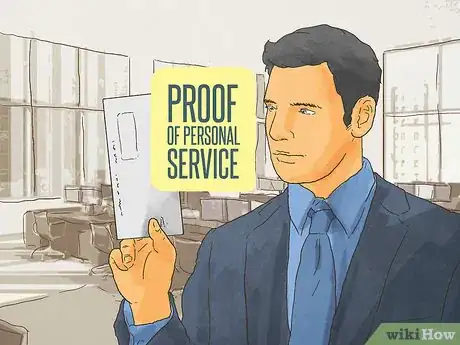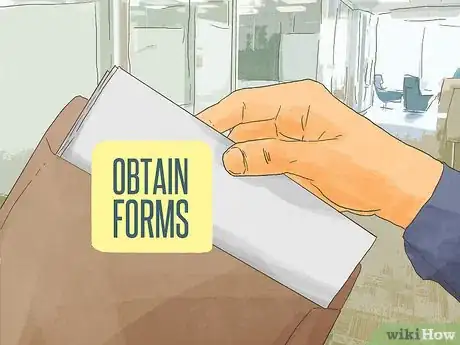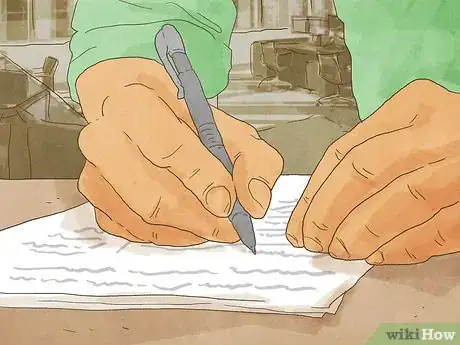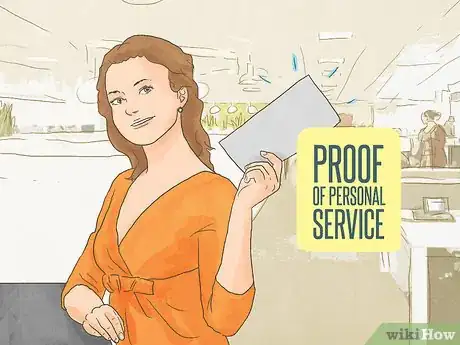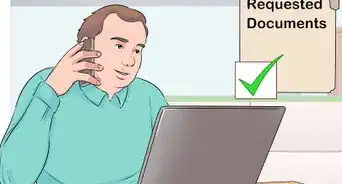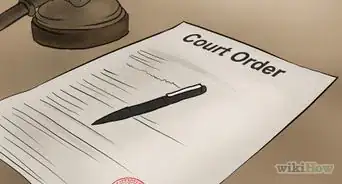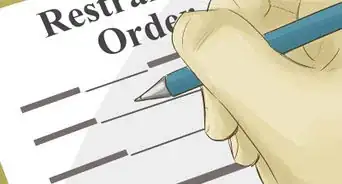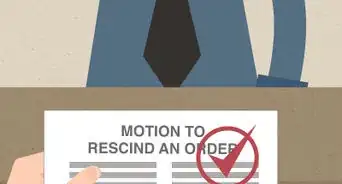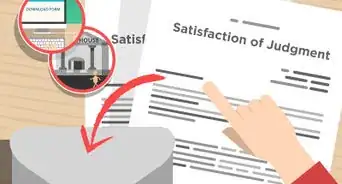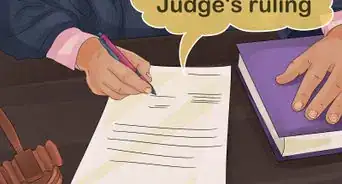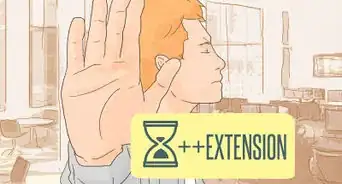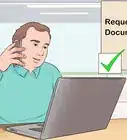This article was co-authored by Clinton M. Sandvick, JD, PhD. Clinton M. Sandvick worked as a civil litigator in California for over 7 years. He received his JD from the University of Wisconsin-Madison in 1998 and his PhD in American History from the University of Oregon in 2013.
There are 19 references cited in this article, which can be found at the bottom of the page.
This article has been viewed 27,256 times.
A restraining order is issued by a judge. It prohibits an individual from coming near the person protected by the order. A restraining order can limit the restrained party from contacting or communicating with the protected person. Restraining orders are a critical device individuals can use if they have experienced physical or mental abuse. In California, restraining orders can be obtained against a variety of people.
Steps
Understanding Restraining Orders
-
1Identify the varieties of restraining orders. In California, there are several different kinds of restraining orders. The orders vary based on the person restrained. There are four kinds of restraining orders:[1]
- Domestic Violence Restraining Orders. This order provides protection from people you were romantically involved with at some point or from close family members.
- Civil Harassment Restraining Orders. This order can be sought to restrain a person with whom you have not had a romantic relationship. It is also appropriate to restrain anyone who is not a close family member.
- Elder or Dependent Abuse Restraining Order. Appropriate if the person being abused is 65 or older or is a dependent between the ages of 18-64.
- Workplace Violence Restraining Order. This order is filed by an employer seeking to protect an employee from violence, stalking, or harassment. It may not be filed by an employee.
-
2Understand the restraints available. A restraining order prevents a person from doing certain things. If the restrained person violates the order, then he or she can be fined, jailed, or both. A restraining order can order a person to:[2] [3]
- Not contact you or any household member
- Not go near you, your children, or others who live with you, regardless of where you go
- Stay away from your school, your children’s school, or your work
- Move out of your house
- Not have a gun
Advertisement -
3Understand temporary restraining orders (TRO). A TRO is a restraining order that can be entered against a person without a hearing. If you need immediate protection, you should seek a TRO. You may apply for it at the same time as you apply for the full restraining order. The temporary restraining order will stay in effect only until a hearing takes place where the person you seek to restrain has an opportunity to tell his or her side of the story to the judge.
- TROs typically last only for a few weeks, after which they will either expire or be replaced by the full restraining order.[4]
- You can apply for a TRO by filling out a form and filing it along with your other forms.
- If for some reason you cannot make the court hearing, then you must petition to extend a TRO before it expires. Fill out and file a Request to Continue Court Hearing and to Reissue Temporary Restraining Order (CH-115). You must do this before the hearing date.[5]
-
4
Filing for a Domestic Violence Restraining Order
-
1Check if this is the appropriate restraining order. You can get a domestic violence restraining order if the person you are seeking to restrain has threatened violence against you, or has severely harassed or stalked you.
- Violence can take many forms:[7]
- physically hurting or trying to hurt someone, whether intentionally or recklessly
- sexual assault
- making someone reasonably afraid that they or someone else is about to be seriously hurt
- behavior like stalking, threatening, harassing, hitting someone, or destroying someone’s personal property
- You may seek a domestic violence restraining order against the following people:[8]
- a spouse or former spouse
- the parent of a child
- someone you share a living space with
- someone you once dated or currently are dating
- any relative to the second degree, e.g., parents, siblings, grandparents or grandchildren
- Violence can take many forms:[7]
-
2Get the appropriate forms. California has created printed “fill in the blank” forms that can be downloaded or filled online and then printed off. They are available from the California Courts website. To get a domestic violence restraining order, you will need the following forms:
- Request for Domestic Violence Restraining Order (DV-100)
- Confidential CLETS Information (CLETS-001)
- Notice of Court Hearing (DV-109)
- Temporary Restraining Order (DV-110) (if necessary)
-
3Request custody. If you have minor children, then you will also need to ask the judge for custody of your children as part of the process. This requires that you fill out additional forms:
-
4Request spousal/partner support or child support. If you want spousal support or child support from the person you are filing the restraining order against, then you will need to fill out certain forms and submit them at the same time.
- Child support: Income and Expense Declaration (FL-150) or Financial Statement (Simplified) (Form FL-155). To see which form to use, answer this questionnaire.
- Spousal/partner support: Form FL-150
-
5Complete the forms. Provide all information requested. Either type the information into the form on your computer or else print neatly using black ink. If you do not want the other party to know where you are currently staying, then you should not put your address on the form. Instead, you should use the Safe at Home program, which will give you a secure address to use.
- If you need additional space, then use a Description of Abuse form (DV-101) or an Additional Page form (MC-020).
- Once you have completed the forms, then assemble them in the following order:
- Attach the Request for Child Custody and Visitation Orders to your Request for Domestic Violence Restraining Order[9]
- Attach the Child Custody and Visitation Order to the Temporary Restraining Order[10]
-
6Have your forms reviewed. You should take your forms to the self-help center or family law facilitator at the courthouse. If the courthouse does not have this personnel, then you should try to meet with an attorney or with someone from a legal aid organization.
-
7File the forms. After making five copies of the forms, take the complete packet to the court clerk and ask to file. There is no filing fee for a domestic violence restraining order.[11]
-
8Pick up a hearing date. After filing, ask the court clerk when you should return to pick up your papers. Typically, the judge reads your documents and makes a decision based on the information provided. Often a decision is made the next business day but it depends on the court.[12]
- When you return to the clerk’s office, you can tell if the judge has granted a Temporary Restraining Order by whether or not the judge signed it.
- The court clerk will file any orders the judge has signed. This makes the order part of the official record of your case. The clerk will give you five copies of the signed order.[13]
-
9Gather forms to serve. Along with your notice, you must serve certain forms on the defendant. You can pick up blank forms, or you can print them off. You will need:
- a copy of your signed TRO (if one was granted)
- Response to Request for Domestic Violence Restraining Order (DV-120)
- Request for Child Custody and Visitation Orders (DV-105) (only if you have children with the person you are seeking to restrain)
- Income and Expense Declaration (FL-150) (only if you are seeking maintenance or child support from the person you are seeking to restrain)
-
10Serve notice on the restrained party. You need to notify the person you seek to restrain of your motion. You have a strict deadline. To calculate the deadline, find the court date on Form DV-109. Then look at the number of days written in item 5 on page two of the form. Subtract the second number from the court date—that’s the deadline. However, there is no reason to wait until the last minute to serve notice. Personal service can be made by the following people:[14]
- A person at least 18 years old who is not protected by the restraining orders.
- A sheriff or other law enforcement officer, who will serve for free.
- A private process server, who you can find online. Process servers typically charge $45-75 per service.
-
11File proof of service. You server should fill out a Proof of Personal Service form and return it to you. You must then file it with the clerk before your hearing. Be sure to take a copy with you to your hearing.[15]
- If you have law enforcement serve notice, then they may use a different form.
Obtaining a Civil Harassment Restraining Order
-
1Identify civil harassment. Civil harassment is stalking, sexual assault, abuse, threats of abuse, or serious harassment by someone you have not dated and not had a close relationship with. Civil harassment is also abuse from a family member who is not included in the list under domestic violence.[16] Typically, a civil harassment restraining order is entered against the following people:
- neighbors
- roommates (who you have never dated)
- friends
- family members more than two degrees removed, such as an aunt or uncle, niece or nephew, cousins, or more distant relatives
- other people you are not closely related to
-
2Get the appropriate forms. To file for a civil harassment restraining order, you will need multiple forms:[17]
- Civil Case Cover Sheet (CM-010) (if needed)
- Notice of Court Hearing (CH-109)
- Temporary Restraining Order (CH-110)
- Request for Civil Harassment Restraining Order (CH-100)
- Confidential CLETS Information (CLETS-001)
- any local form required by your court
-
3Complete the forms. Provide all of the information requested. You can either download the forms and fill in the blanks using black ink or you can type the information into the form online and then print it off.
- After you have completed the forms, you should visit the family law facilitator or self-help center at your courthouse and have your forms reviewed. You want to file a complete set of forms that have been filled out accurately.
-
4Make copies of your forms. After filling out and reviewing your forms, make five copies of each. One copy will be for you and another copy will be for the person you want restrained. The remaining copies are for other people you would like to protect. The original is for the court.
-
5File the forms. You should take all the forms to the court clerk and ask to file. Have the court clerk stamp all of your copies.
-
6Return the next day to pick up your forms. When you file, you should ask the clerk when you can return to pick up your hearing date. If you requested a Temporary Restraining Order, you will know if the judge issued it if it is signed.
- If the Temporary Restraining Order was signed, then the clerk should have filed it, which makes it part of the court’s official record in your case.[20]
-
7Gather forms to serve on the other party. In addition to serving notice, you need to make sure that the restrained party receives certain forms. The person who serves notice will have to give the person these forms, but you need to gather them first:
- Notice of Court Hearing (CH-109) (a file stamped copy)
- Temporary Restraining Order (Ch-110) (a file-stamped copy)
- Request for Civil Harassment Restraining Orders (Ch-110) (a file-stamped copy)
- Response to a Request for Civil Harassment Restraining Order (CH-120) (a blank copy which you should print out)
- Proof of Firearms Turned In, Sold, or Stored (CH-800) (blank copy)
- How Can I Respond to a Request for a Civil Harassment Restraining Order? (CH-120-INFO) (ask the clerk for)
-
8Serve notice on the other party. You must serve all of these forms on the restrained person. California has strict deadlines for when notice must be served. To calculate the deadline, find the court date on Form CH-109. Then look at the number of days written in item 5 on page two of the same form. Subtract the second number from the court date—that’s the deadline. However, there is no reason to wait until the last minute to make service. Personal service may be made in the following ways:[21]
- Someone 18 or older who is not a party to the case. This can be a friend, relative, or coworker.
- A county sheriff or marshal. Ask the court clerk for how to go about scheduling service.
- A professional process server. You can find a registered process server online or in the Yellow Pages. Process servers typically charge $45-75 per service.
-
9File the proof of service. After service is made, have the server fill out a Proof of Personal Service form and return it to you. You must then file it with the clerk.[22]
- Make five copies of the form and have the clerk stamp the copies with the date. Take the copies with you to your court hearing.
- If law enforcement serves the papers, then they may use a different proof of service form.
Obtaining an Elder Abuse or Dependent Adult Abuse Restraining Order
-
1Identify the reasons for this restraining order. You can get an elder or dependent adult abuse restraining order if the person abused is 65 or older or is between the ages of 18 and 64 and a dependent adult. It protects against the following types of abuse:[23]
- physical abuse
- financial abuse
- mental or emotional abuse
- neglect
- abandonment or abduction
- isolation
- deprivation of services or care needed to avoid harm or suffering
-
2Get the forms. You can use the “fill in the blank” forms created by the California Courts and available for download from their website. You will need:[24]
- Request for Elder or Dependent Adult Abuse Restraining Order (EA-100)
- Civil Case Cover Sheet (CM-010) (if required)
- Confidential CLETS Information (CLETS-001)
- Notice of Court Hearing (EA-109)
- Temporary Restraining Order (EA-110) (if necessary)
-
3Complete the forms. You should fill out the Request for Elder or Dependent Adult Abuse Restraining Order and Confidential CLETS Information form. If you need additional pages, then use Form MC-020.
- You must also fill out items 1 and 2 on the Notice of Court Hearing.[25]
- Also fill out items 1, 2, and 3 on the Temporary Restraining Order.
-
4Have forms reviewed. After you have completed all of the forms, you should have them reviewed by someone, either at the courthouse’s self-help center of by the family law facilitator. They can double check to make sure that you have completed everything.[26]
-
5File the forms. After you assemble your forms, make multiple copies and take them to the court clerk to file. You will file the original and the clerk will date stamp all of the copies.
- There is no fee to file an elder or dependent adult abuse restraining order.[27]
-
6Pick up a hearing date. After filing, ask the court clerk when you should return to pick up your papers. Typically, the judge reads your documents and makes a decision based on the information provided. Often a decision is made the next business day but it depends on the court.[28]
- When you return to the clerk’s office, you can tell if the judge has granted a Temporary Restraining Order by whether or not the judge signed it.
- The court clerk will file any orders the judge has signed. This makes the order part of the official record of your case. The clerk will give you five copies of the signed order.[29]
-
7Gather forms to serve on the other party. You must serve notice on the other party. In addition, you must supply them with certain forms:
- Temporary Restraining Order (date-stamped and signed by the judge, if it was granted)
- Response to Request for Elder or Dependent Adult Abuse Restraining Order (EA-120)
- Proof of Firearms Turned In, Sold, or Stored (EA-800)
- How Can I Respond to a Request for Elder or Dependent Adult Abuse Restraining Orders? (EA-120-INFO) (ask the clerk for a copy)
-
8Serve notice on the restrained party. You need to notify the person you seek to restrain of your motion. You have a strict deadline. To calculate that deadline, find the court date on Form EA-109. Then look at the number of days written in item 5 on page two of the form. Subtract the second number from the court date—that’s the deadline. However, there is no reason to wait until the last minute. The following people can serve notice:[30]
- A person at least 18 years old who is not protected by the restraining orders.
- A sheriff or other law enforcement officer, who will serve for free.
- A private process server, who you can find online. Process servers typically charge $45-75 per service.
-
9
Getting a Workplace Violence Restraining Order
-
1Identify the need for a workplace violence restraining order. Only an employer can seek a workplace restraining order. The order is sought to protect an employee from violence or a credible threat of violence if the violence was carried out in the workplace or could reasonably be carried out there.[32]
-
2Get the forms. To file for a workplace restraining order, you will need copies of the following forms, which you can download or pick up at the courthouse:[33]
- Petition for Workplace Violence Restraining Orders (WV-100)
- Confidential CLETS Information (CLETS-001)
- Notice of Court Hearing (WV-109)
- Temporary Restraining Order (WV-110) (if necessary)
- Civil Case Cover Sheet (CM-010)
- any other local forms specific to your court
-
3Complete the forms. Fill out the forms and have them reviewed by the court’s self-help center or by an attorney. Make at least three copies of the forms: one for you, one for the employee, and one for the abuser. If other people need to be protected, make additional copies.[34]
- If you need witness statements to support your application for a restraining order, then make sure those witness statements are written on either a Declaration form (MC-030) or an Attached Declaration (MC-031).
- Make at least three copies of all forms (except CLETS-001, which you should make two copies of).[35]
-
4File. Take all forms to the court clerk and ask to file the original. The clerk should date stamp all of your copies. Also ask when you should return to pick up your papers.
- You may have to pay a filing fee. If the petition claims that there has been violence or threats of violence against the employee, then you probably do not have to pay a fee. In other situations, you might. If you cannot afford the fee, ask for a fee waiver.[36]
-
5Pick up your papers. When you return to retrieve your papers, you will see whether the judge has granted the TRO. If so, serve a copy of the signed TRO along with the other papers on the defendant.
- You should also give a copy of the TRO to the employee.[37]
-
6Gather forms to serve. You must serve certain forms on the defendant. You should print these off or pick up blank ones from the court clerk:
-
7Serve notice. You must serve all of these forms on the restrained person. California has strict deadlines for when notice must be served. To calculate, find the court date, page 1, item 4 on Form WV-109. Then look at the number of days written in item 6 on the form. Subtract the second number from the court date—that’s the deadline. However, there is no reason to wait until the last minute. Personal service may be made in the following ways:[38]
- Someone 18 or older who is not a party to the case. This cannot be either you or the worker you are seeking to protect.
- A county sheriff or marshal. Ask the court clerk for how to go about scheduling service.
- A professional process server. You can find them online or in the Yellow Pages. Process servers typically charge $45-75 per service.
-
8File the proof of service. After service is made, have the server fill out a Proof of Personal Service form and return it to you. You must then file it with the clerk.[39]
- Make multiple copies of the form and have the clerk stamp the copies. Take the copies with you to your court hearing.
References
- ↑ http://www.courts.ca.gov/1044.htm
- ↑ http://www.courts.ca.gov/1044.htm
- ↑ http://www.courts.ca.gov/1260.htm
- ↑ http://www.courts.ca.gov/selfhelp-domesticviolence.htm
- ↑ http://www.courts.ca.gov/1278.htm
- ↑ http://www.courts.ca.gov/documents/ea100info.pdf
- ↑ http://www.courts.ca.gov/selfhelp-domesticviolence.htm
- ↑ http://www.courts.ca.gov/selfhelp-domesticviolence.htm
- ↑ http://www.courts.ca.gov/1264.htm
- ↑ http://www.courts.ca.gov/1264.htm
- ↑ http://www.courts.ca.gov/1264.htm
- ↑ http://www.courts.ca.gov/1264.htm
- ↑ http://www.courts.ca.gov/1264.htm
- ↑ http://www.courts.ca.gov/1264.htm#STEP_1_Fill_Out_Your_Court_Forms_and_Prepare_to_File
- ↑ http://www.courts.ca.gov/1264.htm#STEP_3_Serve_Your_Papers_on_the_Restrained_Person
- ↑ http://www.courts.ca.gov/1044.htm
- ↑ http://www.courts.ca.gov/1278.htm
- ↑ http://www.courts.ca.gov/1278.htm
- ↑ http://www.courts.ca.gov/1278.htm
- ↑ http://www.courts.ca.gov/1278.htm
- ↑ http://www.courts.ca.gov/selfhelp-serving.htm
- ↑ http://www.courts.ca.gov/1278.htm
- ↑ http://www.courts.ca.gov/1273.htm
- ↑ http://www.courts.ca.gov/documents/ea100info.pdf
- ↑ http://www.courts.ca.gov/documents/ea100info.pdf
- ↑ http://www.courts.ca.gov/1273.htm
- ↑ http://www.courts.ca.gov/1273.htm
- ↑ http://www.courts.ca.gov/1273.htm
- ↑ http://www.courts.ca.gov/1273.htm
- ↑ http://www.courts.ca.gov/1273.htm
- ↑ http://www.courts.ca.gov/documents/ea200info.pdf
- ↑ http://www.courts.ca.gov/documents/wv100info.pdf
- ↑ http://www.courts.ca.gov/1283.htm
- ↑ http://www.courts.ca.gov/documents/wv100info.pdf
- ↑ http://www.courts.ca.gov/1283.htm
- ↑ http://www.courts.ca.gov/1283.htm
- ↑ http://www.courts.ca.gov/1283.htm
- ↑ http://www.courts.ca.gov/1283.htm
- ↑ http://www.courts.ca.gov/1283.htm
